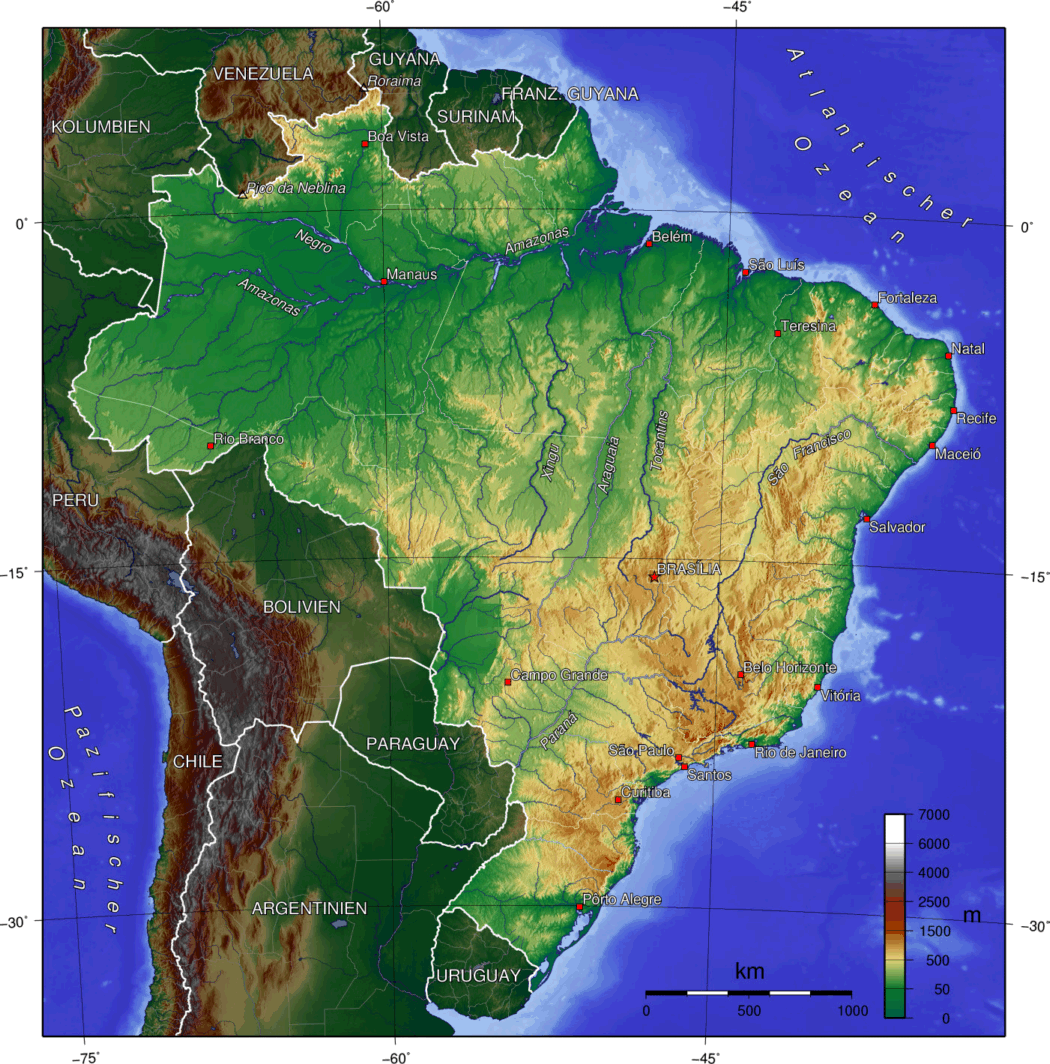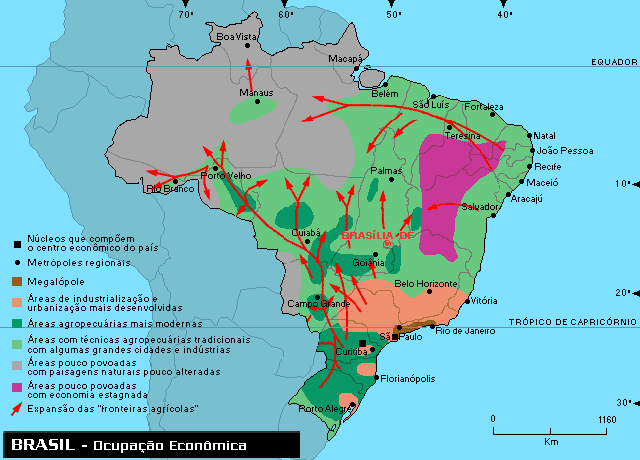

mailto: payer@payer.de
Zitierweise / cite as:
Payer, Margarete <1942 - >: Kulturen von Arbeit und Kapital. -- Teil 3: Kapitaleignerkulturen. -- 8. Brasilien (Brasil): Weltmeister bei Sozialkontrasten. -- 1. Wirtschaft im Ganzen. -- Fassung vom 2005-12-26. -- URL: http://www.payer.de/arbeitkapital/arbeitkapital03081.htm
Erstmals publiziert: 2005-12-26
Überarbeitungen:
Anlass: Lehrveranstaltung an der Hochschule der Medien Stuttgart, Wintersemester 2005/06
Copyright: Dieser Text steht der Allgemeinheit zur Verfügung. Eine Verwertung in Publikationen, die über übliche Zitate hinausgeht, bedarf der ausdrücklichen Genehmigung des Verfassers.

Diese Inhalt ist unter einer
Creative Commons-Lizenz lizenziert.
Dieser Text ist Teil der Abteilung Länder und Kulturen von Tüpfli's Global Village Library

República Federativa do Brasil

![]()
Klicken Sie hier für "Wirtschaft Brasilien" in den
Schlagzeilen

Abb.: Brasilien
(Bildquelle: Wikipedia)

Abb.: Wirtschaftsregionen Brasiliens
[Bildquelle:
http://www.portalbrasil.net/brasil_economia.htm. -- Zugriff am 2005-12-20]
"VERHANDELN IN BRASILIEN
Zwischen Krawatte und Karneval
Von Sergey Frank
Abb.: Brasilianische Geschäftsleute
[Bildquelle: http://www.economist.com.na/2004/29oct/10-29-17.htm. -- Zugriff am 2005-12-24]Brasilianer sind Weltmeister der Improvisation. Stets findet sich ein "jeitinho", ein Dreh, um Probleme zu lösen. Deutsche Manager, die dafür kein Verständnis zeigen, humorlos sind und sich bei Verspätungen schwarz ärgern, kommen als Geschäftspartner nicht zum Zug.
Brasilianer sind fabelhafte Gastgeber und empfangen ihre Gäste auf eine fast familiäre Art und Weise. Sie sind in der Regel optimistisch, lachen gerne und schätzen guten, offenen Humor. "Alegria" - Lebensfreude, spielt eine große Rolle. Oft haben sie das Talent, am Anfang einer Besprechung "das Eis zu brechen" oder in schwierigen Verhandlungen den richtigen Ton zu treffen. Jedoch neigen sie dazu, schwierige Details zu umgehen, statt auf den Punkt zu kommen.
Weltmeister der Improvisation
Sie sind auch Weltmeister der Improvisation, gleichgültig welches Problem es zu lösen gilt, man findet immer "um jeitinho" (einen Dreh, eine Notlösung). Der persönlichen Beziehung wird ein hoher Stellenwert eingeräumt. Eine gute Erziehung und Bildung sowie der familiäre Hintergrund sind besonders wichtig. Der Kommunikationsstil ist sehr extrovertiert. Deshalb sollten wichtige Gespräche persönlich und nicht via Telefon oder Fax durchgeführt werden.
Legen Sie nicht so viel Wert auf kurzfristige Erfolgsversprechen, wenn Sie eine längerfristige Partnerschaft anstreben. Vermeiden Sie es, zu erfolgsorientiert aufzutreten und den Eindruck zu vermitteln, Ihren Geschäftspartner auszunutzen zu wollen. Folglich ist ein gutes und enges Verhältnis die Basis für eine erfolgreiche Zusammenarbeit. Nutzen Sie nicht die Höflichkeit Ihres Partners aus, sonst können Verhandlungen schnell den Charakter wechseln, und zu einem schwierigen und langen Prozess werden.
Patriarchalischer Führungsstil
Die Fähigkeit zuzuhören, ist bei brasilianischen Verhandlungspartnern eher unausgeglichen. Häufiges Unterbrechen erfolgt nicht aus Unhöflichkeit oder Besserwisserei, dahinter steht eher die Absicht, Ihnen zu zeigen, dass sie Ihren Sachverhalt und Standpunkt verstehen. Verglichen mit anderen Nationalitäten, wie zum Beispiel den Japanern, haben die Brasilianer eine eher kurze Geduld, Ihnen zu zuhören.
Im privaten Sektor sind hierarchische Strukturen vorherrschend. Brasilien wird stark von der oberen Mittelschicht dominiert. Die Machtfülle und Autorität eines Geschäftsführers resultiert aus seiner Position, innerhalb der Topdown-Struktur. Zahlreiche brasilianische Unternehmen kennzeichnet ein eher patriarchalischer Führungsstil.
Generell ist die Kommunikation in Brasilien sehr freundlich. Das Verhandlungsteam kann aus einigen wenigen Teilnehmern oder nur einer einzelnen Person bestehen. Innerhalb des Teams sind Diskussionen voraussichtlich sehr lebhaft. Spontane Ideen und schnelles Denken charakterisieren Ihren Partner.
Weniger fixiert auf Terminpläne
Brasilianische Führungskräfte sind sehr flexibel und nicht so fixiert auf Tagesordnungen und Terminpläne. In der Regel sind sie gut vorbereitet und geschickte sowie clevere Verhandlungsführer, die ihre Ziele von Anfang an genau kennen. Sie verfolgen ihre jeweilige Zielsetzung konsequent, selbst wenn ihre Verhandlungsbemühungen für Dritte nicht immer nachvollziehbar sind.
Ihr brasilianischer Partner reagiert und kommuniziert äußerst schnell und wird ein Maximum an Flexibilität aufbringen, um seine Ziele durchzusetzen. Dieses rasche Handeln kann dazu führen, dass Ihr Gegenüber die geführten Gespräche mit anderen aktuellen Projekten verknüpft, in die er involviert ist. Dies sollte Sie nicht stören. Brasilianer können viel Begeisterung für neue Projekte aufbringen.
Sie sollten darauf vorbereitet sein, dass Ihr brasilianischer Partner die Verhandlungen zunächst mit einem hohen Preis eröffnet, um hinlänglich Spielraum für Zugeständnisse zu haben. Verhandlungen und die Kunst des Feilschens werden als soziales Zugeständnis angesehen. Problematische Sachverhalte sollten besser am Ende einer Präsentation diskutiert werden. Krawatten oft erforderlich
Eine elementare Regel lautet: Ihr Verhandlungsstil kann genau und konsistent bleiben, solange das Klima freundlich und einvernehmlich ist. Vergessen Sie nicht, unbeschwert zu wirken und mit Humor zu glänzen, der für den Kommunikationsfluss immer förderlich ist. Die Realisierung von Projekten gehört nicht zu den stärksten Seiten der Brasilianer. Deshalb ist es empfehlenswert darauf zu achten, ob Ihr Partner alle weiteren, abgesprochenen Schritte auch einhält.
Wie auch in einigen anderen südamerikanischen Staaten, arbeitet die Bürokratie in Brasilien eher langsam. Beamte verfügen oftmals über genügenden Einfluss, Ihre Vorhaben zu beschleunigen oder, bei fehlerhaften Verhalten und Besserwisserei, auch zu blockieren. Oft passiert es in Brasilien, dass eine bestimmte Gesetzeslage per Dekret oder Rechtsverordnung schnell einmal geändert wird. Dies geht dann zur Lasten der Rechtssicherheit.
Krawatten erforderlichTrotz hoher Temperaturen sind brasilianische Geschäftsleute konservativ gekleidet. Wenn das Wetter es zulässt, tragen männliche Führungskräfte gewöhnlich elegante Anzüge, oft auch in italienischen und hellen Farben. Krawatten sind nicht nur allgemein üblich, sondern oft erforderlich.
Praktische Tipps
- Feilschen gehört zum Alltag in Brasilien. Lassen Sie Spielraum für Konzessionen in Ihrer Kalkulation.
- Während Sie verhandeln ist es schwierig, konkrete Antworten zu bekommen. "Ja" heißt maximal "Wahrscheinlich", und "Nein" kommt so gut wie gar nicht vor. Drängendes Verhalten wird als aggressiv empfunden, daher: Erst einmal eine gute Beziehung etablieren, lächeln und sich wirklich für die Person, deren Einstellungen, Werte und Bedürfnisse interessieren. Das ist nicht schwer, da die meisten Brasilianer sehr offen und herzlich sind. Die Anrede erfolgt meistens mit "Senhor" (bei Männern) und "Dona" (bei Frauen) plus Vornamen, man ist dann auch schnell beim "Du".
- In Anbetracht der turbulenten Verkehrssituationen in Rio und São Paulo, aber auch weil die Brasilianer einfach einen anderen Umgang mit der Zeit haben, sind Verspätungen bis zu einer Stunde keine Seltenheit und werden durchaus toleriert.
- Viele Geschäftsleute sprechen zwar Englisch, dennoch ist es besser, auf Portugiesisch zu verhandeln. Angebote, technische Dokumente und Bedienungsunterlagen sollten generell ins Portugiesische übersetzt werden. Oft treffen Sie auch Geschäftsleute die beides, Spanisch und Portugiesisch oder auch eine Mischung beider Sprachen ("Portunhol" oder umgekehrt vom Spanischen kommend "Espanhês") sprechen.
- Die Brasilianer sind sehr gastfreundlich. Einladungen führen meistens in Clubs oder Restaurants. Gemeinsames Essen dient der Beziehungspflege, Geschäfte werden erst nach dem Kaffee besprochen.
- Brasilianische Unternehmen sind deutlich hierarchisch gegliedert. Die mittlere Managementebene gibt es eher selten. Setzen Sie die Verhandlungen in der Hierarchie möglichst hoch an. Entscheidungsgewalt hat meistens nur der Geschäftsführer."
[Quelle: Sergey Frank. -- http://www.manager-magazin.de/koepfe/karriere/0,2828,339628-3,00.html. -- Zugriff am 2005-12-18]

Abb.: Markt in Rio de Janeiro / von Klaus Oppermann
[Bildquelle: www.ipicture.de. -- Zugriff am
2005-12-24]

Abb.: Centralmarkt, Fortaleza, 2005 / von Peter Jurgilewitsch
[Bildquelle: www.ipicture.de. -- Zugriff am
2005-12-24]
"Träum weiter, Brasilien
Die Wirtschaft wächst. Doch hohe Staatsschulden, Korruption und eine marode Infrastruktur hindern das Land daran, sein Potenzial auszuschöpfen
Von Christiane Henkel
Abb.: Lage von Paranaguá
(©MS Encarta)
Vor dem Hafen in Paranaguá im Süden Brasiliens stauen sich auf einer Strecke von fast hundert Kilometern mit Soja beladene Lastwagen. Draußen im Meer liegen Dutzende von Ozeanfrachtern und warten auf Ladung. Die Hafenarbeiter tun in diesen Tagen, was sie können – aber das reicht nicht. Die Sojaproduktion hat sich in fünf Jahren auf 52 Millionen Tonnen nahezu verdoppelt, doch beim Getreide- und Düngemittelhersteller Bunge ist die Goldgräberstimmung längst verflogen. »Drei Prozent der Ladung gehen auf dem Landweg verloren, durch Unfälle auf den maroden Strassen, Überfälle und Verderb. Und jeder Tag, den ein Schiff auf Beladung warten muss, kostet 50000 Dollar«, rechnet Adalgiso Telles vor, Vorstandssprecher von Brasiliens größtem Agrarexporteur.
Abb.: Reklame von Bunge BrasilEine von Bunge in Auftrag gegebene Studie schätzt, dass den Getreidehändlern der Schwund auf den Strassen und die Schlangen an den Häfen pro Jahr 2,4 Milliarden Dollar oder zehn Prozent des Exports kosten. Und es könnte noch schlimmer kommen, im nächsten Jahr, wenn die Ausfuhren an Getreide laut Prognosen einen neuen Mengenrekord erreichen werden. »Bisher war es die Nachfrage, nach der wir unsere Produktionsmenge ausgerichtet haben. Im nächsten Jahr werden es die Abfertigungskapazitäten in den Häfen sein«, beschreibt Telles den bedrohlichen Engpass.
Die Agrarindustrie zieht die Wirtschaft aus dem Tief
Rund vier Prozent soll das Bruttoinlandsprodukt von Brasilien in diesem Jahr zulegen. Es sind die Exporte, vor allem die der Agrarindustrie, die die Wirtschaft aus dem Tief ziehen. Allen Widrigkeiten zum Trotz glaubt Ben van Schaik, Präsident der deutsch-brasilianischen Handelskammer in São Paulo und Präsident von DaimlerChrysler do Brasil, es sei eine neue Ära des Wachstums angebrochen. »Vier Prozent Wachstum jährlich, während der nächsten fünf Jahre« erwartet er. Solcher Optimismus hat schon viele Beobachter des an natürlichen Ressourcen so reichen Landes erfasst, seit vor rund fünf Jahrhunderten die Schiffe des portugiesischen Seefahrers Pedro Álvares Cabral gelandet waren. Heute ist Brasilien ein riesiger Binnenmarkt mit 179 Millionen Einwohnern, eine gefestigte Demokratie zumal, die auch unter dem linken Präsidenten Luiz Inácio »Lula« da Silva eine stabilitätsorientierte Haushaltspolitik betreibt. So glaubt denn auch Lula selbst, es stehe nun kurz bevor, das Wirtschaftswunder. Den Status als Schwellenland endlich hinter sich zu lassen, davon träumen viele hier.
Doch es wird auch dieses Mal wieder ein Traum bleiben.
Der drohende Kollaps der Infrastruktur ist nur eine von vielen Hürden für hohes und dauerhaftes Wachstum, neben dem Duo infernale – Bürokratie und Korruption – und der mangelnden internationalen Wettbewerbsfähigkeit vieler Branchen. Als größte Hürde gilt indes die Staatsverschuldung: Sie kann das Land jederzeit an den Rand des Bankrotts treiben – oder darüber hinaus.
Abb.: RealMit rund 924 Milliarden Real (rund 295 Milliarden Dollar), das entspricht etwa 57 Prozent des Bruttoinlandsproduktes, steht Brasilien in der Kreide. Vor allem die Zusammensetzung des Schuldenbergs erregt Besorgnis. Ein Großteil ist an die Entwicklung von Dollar und heimischen Zinsen gekoppelt, und deren Anstieg lässt den Schuldendienst schnell auf bedrohliche Ausmaße anwachsen. Problematisch sind auch die kurzen Laufzeiten vieler Staatsanleihen, von denen in den nächsten zwölf Monaten rund 40 Prozent fällig werden. Zwar kaufen die Investoren in ruhigen Zeiten sofort neue Staatsanleihen, doch wenn sie an der Zuverlässigkeit des Schuldners Brasilien zu zweifeln beginnen, wird es ernst – so wie in den Monaten vor den letzten Präsidentschaftswahlen Ende 2002.
Damals war es zu einer unschönen, sich selbst verstärkenden Kettenreaktion gekommen: Viele Banken und Anleger zogen aus Angst vor einem möglicherweise sozialistischen Präsidenten Lula ihr Geld aus Brasilien ab. Die Regierung musste fällig werdende Schuldtitel auszahlen oder sehr viel höhere Zinsen bieten, der Real ging auf Talfahrt, und Brasilien geriet an den Rand einer Krise. Diese Gefahr ist langfristig nicht gebannt. Ein unglückliches Zusammentreffen von steigenden US-Zinsen – an denen sich die brasilianischen Staatsanleihen orientieren –, fallenden Rohstoffpreisen und irgendwelchen Anzeichen, dass Brasilien seine sparsame Ausgabenpolitik aufgeben würde, und 2002 könnte sich wiederholen.
Selbst wenn es nicht so weit kommt: Bereits im Alltag ist die Verschuldung eine Bürde. Der hohe Geldbedarf des Staates lässt für die Privatwirtschaft kaum noch einen Real übrig. Brasilianer investieren ihre Ersparnisse lieber in die zwar riskanten, aber hoch verzinsten Staatsanleihen, als sie aufs Sparbuch zu tragen. Das wiederum begrenzt den Spielraum der Banken, weil die Einlagen die Grundlage für das Kreditgeschäft sind. Marcelo Trindade, Präsident der Börsenaufsichtskommission, stöhnt: »Gegen die Übermacht der attraktiven Staatsanleihen ist nur schwer anzukommen.« Kredite sind also rar und mit jährlichen Zinsen von bis zu 50 Prozent für die meisten Unternehmen unerschwinglich. Investiert werden kann oft nur, was am Ende des Jahres als Gewinn übrig geblieben ist.
Was Beobachter hoffen lässt, ist die Tatsache, dass Brasilien heute prinzipiell besser als je zuvor darauf vorbereitet ist, sich aus der Riege der Schwellenländer herauszulösen. Das Land erfüllt mittlerweile einige Voraussetzungen für nachhaltiges Wachstum. Nach dem Übergang zur Demokratie in den achtziger Jahren und den wirtschaftlichen Reformen in den neunziger Jahren kann es heute auf ein Wirtschaftssystem mit freien Wechselkursen, den Sieg über die Inflation und eine stabilitätsorientierte Geld- und Fiskalpolitik verweisen. Auch hat das Land einige industrielle Kerne: Fast alle internationalen Automobilhersteller lassen in Brasilien für den südamerikanischen Markt fertigen, der Erdölkonzern Petrobras und der Bergbauriese Companhia Vale do Rio Doce gehören zu den weltweit Größten ihrer Branche. Und nicht zuletzt ist der Flugzeugbauer Embraer ein geachteter Wettbewerber von Airbus und Boeing.
Die allgemeine Investitionsneigung, oder besser: -abneigung, hängt in Brasilien aber eben längst nicht nur von industriellen Kernen und der Frage ab, wie hoch der Zins liegt. Sergio Abranches, Direktor der auf politische Risikoberatung spezialisierten Firma Sócio Dinâmica Aplicada, stellt denn auch klar: »Viele Investoren warten ab, weil Reformen auf der Mikroebene ausbleiben.«
Der Sojakonzern Bunge etwa hatte sich schon dazu durchgerungen, sein Infrastrukturproblem selbst zu lösen. Bunge wollte in den nächsten vier Jahren 350 Millionen Dollar – das entspricht einem Viertel der gesamten Investitionen des Unternehmens in diesem Zeitraum – vor allem in Hafenanlagen investieren. »Doch damit kommen wieder neue Probleme«, sagt Vorstandssprecher Telles und verweist auf bisherige Erfahrungen. Der Konzern bewilligte vor zwei Jahren schon einmal zehn Millionen Dollar für den Ausbau des Hafens von Santos und vor vier Jahren 30 Millionen Dollar für den Hafen von São Francisco do Sul. »Das Geld liegt bereit«, so Telles, aber »die Anträge stecken in den staatlichen Stellen zwischen Kompetenzwirrwarr und Bürokratie fest«.
Diese Ineffizienz erschwert es den Firmen des Landes auch, innovative und konkurrenzfähige Produkte und Dienstleistungen jenseits von Soja, Erdöl, Erzen und Flugzeugen zu entwickeln. Brasiliens Artenvielfalt im Amazonasgebiet beispielsweise wäre ein Eldorado für die Biotechnologie und könnte aller Wahrscheinlichkeit nach zukunftsträchtige Exportschlager hervorbringen. Zwei Jahre aber brauchte Antonio Paes de Carvalho, Direktor der Biotechnologie-Firma Extracta, um eine Lizenz zu bekommen: »Die Branche könnte schon viel weiter sein, wenn der Staat zumindest einen verlässlichen regulatorischen Rahmen aufstellen würde.«
Manager zahlen Schmiergelder und nennen es »custo Brasil«
Von der Weltbank wurde die Investitionsbremse »Staat« jüngst wieder in Zahlen gefasst: Elf Schritte sind in Brasilien notwendig, um ein Unternehmen zu eröffnen. 155 Tage dauert diese Prozedur, und in nur sechs der 133 untersuchten Länder verstreicht noch mehr Zeit. Ohne Rechtsanwälte und so genannte despachantes – meist zwielichtige Gestalten, die mit ebenso zwielichtigen Methoden in den Behörden im Unternehmensinteresse tätig werden – geht in Brasiliens Ämtern nichts voran. Und natürlich darf das Schmiermittel nicht fehlen. Claudio Weber Abramo, Direktor von Transperência Brasil, einer Organisation, die sich dem Kampf gegen Korruption verschrieben hat, kommt in einer Befragung unter Geschäftsleuten zu dem Ergebnis: Ein Viertel von ihnen reserviert fünf bis zehn Prozent des Umsatzes für Bestechungsgelder. Vier Fünftel aller Befragten halten Korruption für eine sehr große Barriere für die Entwicklung ihrer Firma.
Viele Unternehmen haben diese Probleme bereits in den informellen Sektor getrieben. Laut Schätzungen der Weltbank werden rund 40 Prozent des Bruttoinlandsproduktes von Unternehmen erwirtschaftet, denen die Nachteile des Untergrunds lieber sind als die Vorteile der Legalität – wie etwa der reguläre Zugang zu Banken oder Justiz.So addieren sich Korruption und Bürokratie – von der Kriminalität ganz zu schweigen – zu dem, worüber fast jeder Unternehmer in Brasilien stöhnt: custo Brasil – Brasiliens Zusatzkosten. Im weltweiten Wettbewerb ist das nicht gerade ein Vorteil. Die Wirtschaftskaderschmiede IMD in Lausanne hat Brasilien wegen seiner mangelnden Wettbewerbsfähigkeit lediglich auf Platz 53 von 60 eingeordnet, nachdem das Land vor vier Jahren noch immerhin auf Platz 38 gelegen hatte. Parallel dazu ist Brasiliens Anteil am Welthandel von 1,4 Prozent im Jahr 1984 auf 0,8Prozent im Jahr 2002 zurückgegangen.
Erst musste Brasilien mit ansehen, wie die kleinen Tigerstaaten in Südostasien mit zweistelligen Wachstumsraten den Rest der Welt entzückten. »Und nun ziehen auch noch die Wale an uns vorbei«, konstatierte Expräsident Fernando Henrique Cardoso vor kurzem in Anspielung auf die augenfällige Wirtschaftsdynamik Chinas und Indiens. Jim O’Neill zum Beispiel, Chefvolkswirt der US-Investmentbank Goldman Sachs, rechnet damit, dass Brasilien erst in 50 Jahren hinter China, den USA, Indien und Japan zur fünftgrößten Volkswirtschaft aufsteigen kann. Und das auch nur, wenn es die hohe Verschuldung, die geringe Öffnung der Wirtschaft für den Außenhandel und das schlechte Investitionsklima beseitige. Ja, wenn."
[Quelle: Christiane Henkel. -- In: ©DIE ZEIT. -- Nr. 31 (2004-07-22). -- http://www.zeit.de/2004/31/Brasilien?page=all. -- Zugriff am 2005-12-18]
"Economic Survey of Brazil 2005 /OECD Macroeconomic policies: paving the way for sustained growth
The following OECD assessment and recommendations summarise chapter 1 of the Economic Survey of Brazil 2005.
The Brazilian economy is bouncing back
Brazil’s growth performance has been erratic in recent years but the foundations for a sustained recovery appear to be broadly in place. The measures implemented by the new administration, which took office in January 2003, have contributed to gradually restoring confidence, which had faltered during and in the aftermath of the presidential election in 2002. These measures have succeeded in stabilizing foreign exchange markets, reducing sovereign credit risk, and taming inflation. At the same time, the remarkable external adjustment since the floating of the real in 1999, with continued strong export performance and the ensuing turnaround in the external current account, is making the economy less dependent on foreign financing and, consequently, more resilient to changes in market sentiment. But more is needed, particularly in keeping the momentum of the reform process, to ensure that this positive outlook ushers in a virtuous circle of improved confidence and resilient, equitable growth.
Having posted anaemic growth in 2001-02 and then stagnated in 2003, following the faltering of confidence in 2002, the economy grew briskly in the first half of 2004, well above market expectations. GDP growth is expected to be about 4½ per cent in 2004, facilitated by the monetary easing that took place from the second half of 2003 to mid-2004, and the restoration of confidence. Domestic demand is strengthening, taking over from a period of strong increase in net exports. Private consumption is recovering, pushed by the expansion of credit and improvements in the labour market. Formal unemployment remains high in the major cities but is trending down and real wages are on the rise, having stagnated or fallen in recent years. An improving climate for business is providing further impetus for private investment, which is showing signs of recovery. Net exports will continue to contribute positively to growth, in addition to keeping the external current account in surplus. This is important for sustained recovery as the external sector has been Brazil’s Achilles heel for many years, constraining growth. The gradual reduction in trade restrictions throughout the 1990s has made foreign trade more responsive to external price signals and changes in relative prices. Continued effort to further remove trade restrictions is therefore welcome. It is also important to note that export growth remains constrained in key markets by tariff and non-tariff barriers, particularly in agriculture.
The improvement in the economic outlook owes much to the strengthening of institutions. The maintenance of macroeconomic discipline and the prompt policy response to adverse shocks would probably not have been possible without the reforms in this area. This perception seems to be entrenched in Brazilian society, making the strengthening of institutions an on-going process. Of particular importance in the macro area are the inflation targeting framework for monetary policymaking and the Fiscal Responsibility legislation. These have become the main institutional pillars for macroeconomic management and consolidation. These institutions have been put to the test but have withstood the succession of negative shocks the economy has faced in the past few years. The 2001 OECD Survey of Brazil had been particularly sceptical about the resilience of Fiscal Responsibility legislation. The authorities should be praised for their continued resolve in defending and strengthening these institutions, even in adverse conditions.
The consolidation of macroeconomic stabilisation should continue
The consolidation of macroeconomic stabilisation, which will require vigilance on the part of the authorities, is of paramount importance in the years to come, anchored by a prudent monetary-fiscal policy mix in pursuit of continued disinflation and a steady reduction in public indebtedness.
What are Brazil’s main challenges?
Notwithstanding several accomplishments, there are three main challenges identified in the Survey which need to be addressed. These are:
These challenges are interrelated. They also require a comprehensive set of measures in order to consolidate recent achievements, boosting the economy’s resilience to shocks and paving the way for sustainable, more resilient growth and for a faster catch-up in relative living standards.
On the fiscal side, the government’s record in meeting the annual budget targets is commendable, even in adverse conditions, making the fiscal effort all the more impressive. But fiscal adjustment has been contemporaneous with the increase in primary expenditure, thus being achieved in recent years primarily by hiking revenue and compressing public investment. Non-mandatory spending commitments have at times been curbed through the ad hoc sequestration of funds during the fiscal year, making budget execution more difficult, in part to accommodate higher-than-expected increases in entitlements. This is because the retrenchment of current spending has become increasingly difficult owing predominantly to downward rigidities in the budget. Revenue earmarking is widespread and minimum expenditure levels have been introduced over the years, often through constitutional provisions, severely curtailing budget flexibility. Also, until 2003, reform of the social security regime for civil servants had lagged behind that of the private-sector regime, placing a heavy burden on the budget. The authorities should be praised for avoiding increases in the minimum wage above inflation, which would have had a detrimental impact on the budget, underscoring their commitment to fiscal rectitude. In spite of recent progress, more emphasis should be put on rationalizing the largest items of current spending to improve the quality of on-going fiscal consolidation.
By tackling these problems, the need for fiscal consolidation can be reconciled with that of alleviating Brazil’s already high tax burden in the years to come, better channelling budgetary resources to meet society’s economic and social priorities. Brazil’s revenue ratio, at close to 35 per cent of GDP, is already high by international comparison and close to the OECD average. It is detrimental not only to growth but also to the labour market, encouraging informality. This is confirmed by international comparison, based on the OECD methodology for assessing the rigidity of employment protection legislation, which suggests that informality in Brazil appears to be more of a fiscal, rather than legal, problem. Alleviating the tax burden on labour would make social security more affordable to lower-productivity workers in the informal sector, while making it more attractive for employers to hire them with a formal contract. Nevertheless, there appears to be limited agreement on how this can be achieved, underscoring the need for a comprehensive labour reform. Options for making social insurance affordable to those with low incomes include, for example, variable contribution rates, either by making them progressive or by allowing individuals to choose between alternative levels of protection. By the same token, discussion on the gradual replacement of at least part of employers’ social security contributions by levies on value added could be encouraged. Brazil’s indirect tax system has become more efficient in recent years through the conversion of federal levies on enterprise turnover (starting with PIS/Pasep in 2002 and COFINS in 2003) into value added-type taxes. Against this background, policy effort is needed to reduce the tax burden over time, once public finances have strengthened, and to gradually increase reliance on direct, rather than indirect, taxes, reviewing the role inter alia of corporate income taxes, including CSLL.
There appears to be widespread recognition that rigidities in the budget adversely affect the quality of fiscal adjustment. Of particular importance is the on-going policy debate about the constitutional provision linking adjustments in the minimum pension to those in the minimum wage. The option of severing this link while preserving the purchasing power of pensions should therefore be considered. In health care, a constitutional amendment enacted in 2000 sets a floor for aggregate federal spending, while the earmarking of federal transfers also increases sub-national spending, placing Brazil among the countries with high levels of public expenditure on health care in relation to GDP. In education, minimum spending levels per student enrolled in primary and lower-secondary education (1st to 8th grades) have been established, requiring the federal government to top up outlays in the states that cannot afford the national spending floor. In this context, a comprehensive assessment of existing revenue earmarking and mandated spending requirements against the achievement of their intended policy objectives could pave the way for more cost-effective spending.
Further social security reform will be needed to ensure that the social security system is financially sustainable over time. This is a pre-requisite for making room in the budget for higher spending on more cost-effective programmes, and for increasing Brazil’s preparedness to cope in the years to come with the spending pressures associated with a fairly rapidly ageing population. The share of population aged 65 and over is projected to nearly double to about 9 per cent by 2020, a rapid pace of demographic change in comparison with OECD countries. An important problem in this area is that the social security regime for civil servants acts as a drain on the budget, accounting for two-thirds of the overall social security deficit. And civil servants continue to benefit from more advantageous pension entitlements than their counterparts in the private sector. These distortions underscore the need for reform, which is under way. The main pending issues in this regard are twofold: i) to create defined-contribution complementary pension funds for civil servants subject to the same prudential regulations and operational rules as those for private-sector workers; and ii) at a later stage, to aim at unifying the pension regimes for federal, state, and municipal civil servants, and standardizing entitlements between the regimes for private- and public-sector workers. Further reform in the social security regime for private-sector workers is also needed and could focus on the introduction of a minimum retirement age, further elimination of exemptions and increasing the contribution period.
The rationalization of current public expenditure would free budgetary resources which could be channelled to finance higher, externality-rich public investment. At the same time, the reduction in indebtedness, as discussed above, should help reduce the crowding out of private investment. New legislation on public-private partnerships (PPPs), which have hitherto been confined predominantly to leasing operations and concessions, will complement the current legal framework for public procurement, thereby militating to encourage private investment, particularly in infrastructure. Public-private partnerships will need to be encouraged in a fiscally-sound manner, adequately balancing risks between the government and its private-sector partners. There appears to be widespread recognition that fiscal consolidation should not be undermined and that the federal government should set standards for the states and municipalities in this area. An important policy objective is therefore to standardize requirements for the accounting and reporting of PPP operations, as well as the dissemination of information to markets and society at large, together with the risk assessment of individual projects. Draft legislation envisages a leading role for the Treasury in this area. In this regard, the Fiscal Targets Annex of the Budget Guidelines Law (LDO), which each level of government is required to submit to their legislatures, could be the main vehicle for the dissemination of information on PPPs in budget documentation.
Further developing financial markets
The following OECD assessment and recommendations summarise chapter 2 of the Economic Survey of Brazil 2005.Private investment can be encouraged by facilitating access to cheaper, more abundant credit
Brazil’s financial markets will need to develop further to facilitate access by private investors to more abundant, cheaper credit. New bankruptcy legislation, once approved, is expected to ease constraints on loan recovery, while protecting the value of collateral and jobs. This is a necessary, although not sufficient, condition for encouraging credit creation and reducing intermediation costs. The real test for the reform strategy will nevertheless be in implementation. Additional measures to encourage the expansion of credit and reduce intermediation costs would include the gradual phasing out of directed credits to agriculture and housing, while remaining attentive to the need for public action in the case of market failures, especially with respect to low-income households; the gradual alleviation of the tax burden on financial intermediation, once public finances improve; and continued strengthening of the credit information industry, primarily by enhancing portability of positive information on credit history. Other measures in the government’s broad structural reform agenda includes the on-going reform of the legal system and initiatives to encourage housing finance, which can do much to improve the security of property rights, lowering borrowing costs.
Enhancing the regulatory framework
The following OECD assessment and recommendations summarise chapter 3 of the Economic Survey of Brazil 2005.
Reducing regulatory uncertainty will imrpove the investment climate
The current level of investment, particularly in infrastructure, is insufficient to sustain robust growth over the medium term. On the one hand, there is limited room in the budget to boost public capital spending at the current juncture. On the other, private investment is discouraged by a scarcity of credit, high intermediation costs, and regulatory uncertainty in several sectors. Macroeconomic volatility also weighs heavily on private investment. This is despite the fact that Brazil appears to offer a reasonably investor-friendly environment for business, based on OECD work on the restrictiveness of product market regulations and legislation on foreign direct investment (FDI). In this respect, policies that promote investment and reduce firms’ costs of doing business more generally would also contribute to tackling informality. Enhancing the investment climate will therefore be critical to improving the economy’s growth performance and resilience.
The rationalization of current public expenditure would free budgetary resources which could be channelled to finance higher, externality-rich public investment. At the same time, the reduction in indebtedness, as discussed above, should help reduce the crowding out of private investment. New legislation on public-private partnerships (PPPs), which have hitherto been confined predominantly to leasing operations and concessions, will complement the current legal framework for public procurement, thereby militating to encourage private investment, particularly in infrastructure. Public-private partnerships will need to be encouraged in a fiscally-sound manner, adequately balancing risks between the government and its private-sector partners. There appears to be widespread recognition that fiscal consolidation should not be undermined and that the federal government should set standards for the states and municipalities in this area. An important policy objective is therefore to standardize requirements for the accounting and reporting of PPP operations, as well as the dissemination of information to markets and society at large, together with the risk assessment of individual projects. Draft legislation envisages a leading role for the Treasury in this area. In this regard, the Fiscal Targets Annex of the Budget Guidelines Law (LDO), which each level of government is required to submit to their legislatures, could be the main vehicle for the dissemination of information on PPPs in budget documentation.
Brazil’s regulatory framework for network industries (i.e., electricity, oil and gas, water and sanitation) will need to clearly define the role of government in these sectors. Regulatory uncertainty weighs on private investment and therefore needs to be reduced, particularly in network industries. The overall approach to regulatory reform in the electricity sector, based on arms-length operations and public auctions, is well thought out but the risk of regulatory failure should not be underestimated, given the enhanced role of government in long-term planning. But, again, implementation will be the ultimate test of reform in this area. In natural gas, the dominance of Petrobras, the national oil company, throughout the industry has often been perceived as an obstacle to its development. Private investment in water and sanitation, which is much needed in light of relatively low connection rates to sewerage, is constrained by a lack of clarity over the assignment of regulatory powers across different levels of government. The share of wastewater that is treated is also low, with a detrimental impact on the environment.
Strengthening social policies and expenditure
The following OECD assessment and recommendations summarise chapter 4 of the Economic Survey of Brazil 2005.
Brazil’s social indicators are not always commensurate with high spending levels on social programmes
There seems to be widespread agreement within the government and beyond that social disparities do not allow for the benefits of sustained growth to be evenly spread among different social groups. Social exclusion prevents vulnerable groups from acquiring labour market-relevant skills, contributing to high unemployment and informality among these groups, as well as perpetuating income inequality. The main challenge in this respect is to strengthen the social policies that will allow for the pursuit of the government’s social agenda while maintaining fiscal discipline and galvanising support for furthering structural reform. Much has been done in the social area over the last decade or so, with unquestionable improvements in key social indicators, particularly in education. The government nevertheless continues to have an important role to play, ensuring that social outcomes are commensurate with Brazil’s already high levels of spending on social programmes, including pensions. General government spending on social programmes — including education, health care, housing and urbanisation, social security and assistance, and unemployment insurance — accounts for about one-quarter of GDP, well in excess of average spending in countries with a comparable level of income. In light of these high spending levels, emphasis should gradually be shifted to improving the cost-effectiveness of social programmes, focusing on continuity through an incremental strengthening of existing programmes and improvements in service delivery.
The distribution of income remains stubbornly skewed in Brazil. Public social spending is a poor instrument to redistribute income because contributory programmes, such as pensions and unemployment insurance, account for the lion’s share of public social spending. These programmes are also reserved for formal-sector workers, who tend to have above-average incomes. Public spending on pensions alone already accounts for a higher share of GDP in Brazil than in the average OECD country, despite Brazil’s younger population. But spending on means-tested programmes, such as income transfers for the care of children, and elderly and disabled persons, accounts for a relatively small share of public social spending, well below the OECD average. Rural pensions, which are essentially non-contributory, are considered one of the best-targeted social programmes currently in place. Due to broad recognition that these income transfers are important poverty alleviation tools, they have been preserved from cuts in periods of fiscal retrenchment. To correct these structural imbalances within the current budget envelope, the financial sustainability of the social security system will need to be restored to make room for higher spending on programmes which are more pro-poor and conducive to the accumulation of human capital.
Abb.. Composition of general government social spending, 2002Social policies can become more pro-poor
Untargeted social spending, especially on education and health care, can also become more pro-poor. This can be achieved by continuing to shift the composition of spending towards preventive care and primary and lower-secondary education, which tend to benefit the poor more than others. For example, the share in GDP of public spending on education is close to the OECD average but Brazil fares poorly in the OECD’s PISA measurement of student performance in comparison with countries with similar levels of public spending on education. Tertiary education accounts for about one-fifth of government spending on education, close to the OECD average, but the average cost to the budget of higher education per student is about 150 per cent of GDP per capita, about three times as high as the OECD average. The option of increasing cost recovery in higher education through the better targeting of existing tax expenditures directed to philanthropic institutions is thus welcome. With regard to improving access to primary and lower-secondary education, the experience of FUNDEF (a fund to finance sub-national spending on primary and lower-secondary education based on minimum spending per student and federal top-up grants), with its impact on school enrolment rates, is welcome. This is also true for greater reliance in programme design and service delivery on the conditional, means-tested income transfers, including those now under the Bolsa Família umbrella. In recognition of the fact that poverty can be alleviated and income distribution can be improved over the longer term through human capital accumulation, continued use of school attendance as a condition for enrolment in income transfer programmes is strongly advisable. So is the appropriate monitoring of compliance with programme conditionality."
[Quelle:http://www.oecd.org/document/60/0,2340,en_2649_34571_34413308_1_1_1_1,00.html. -- Zugriff am 2005-12-24]
Zu 8.2.: Brasilien: Landwirtschaft